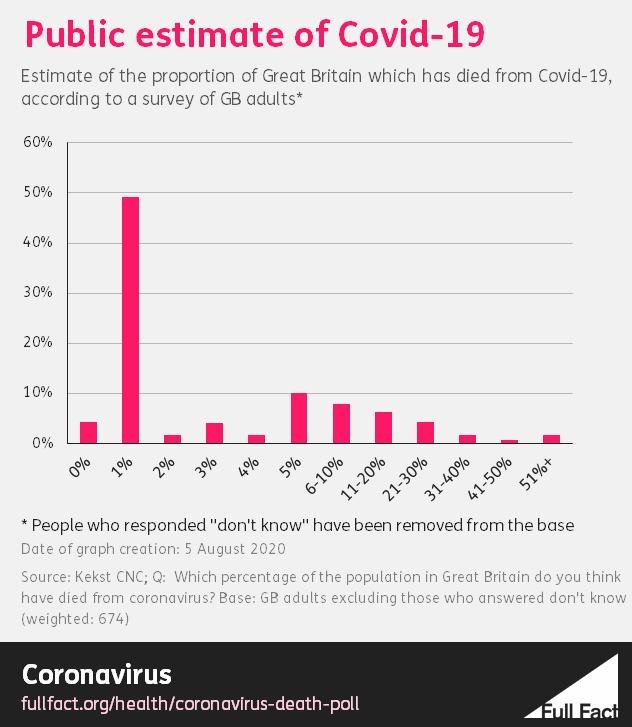Full Facts have shown how Toby Young and Guido Fawkes have totally misrepresented a poll by not applying the correct statistical average.
‘Last week, Twitter was awash with claims about how many people the British public think had died from Covid-19.
“Scottish people think COVID-19 has killed 10% of the U.K. population,” said Toby Young. “The British public believe a whopping 7% of the UK population has died from Coronavirus, a number 100 times higher than the recorded-death reality,” reported blog Guido Fawkes.
The true proportion of the British population who have died from Covid-19 is around 0.1%.
These claims stemmed from research commissioned by consultancy firm Kekst CNC.
The problem was that the way the data had been reported, using a mean average, rather than a median, misrepresented what the public really thought about the death rate.
And putting that aside, the way the research was designed means it could have encouraged some people to overestimate the true death toll.
Means and medians
The mean is probably the most common way to average numbers, calculated by adding up all the data points in a set and dividing by the number of data points. For example, to find the mean height of a group of people, you would add up all their heights and divide by the number of people.
But sometimes the mean isn’t a suitable measure of the typical or the average. In particular it’s not suitable when you have either a very wide range or a very skewed distribution of data.
For example, in the UK we often talk about income using a median figure. The median is the middle value of a list. For example the median of the incomes £15,000, £20,000, £25,000, £30,000 and £1 million would be £25,000.
The median is better than the mean as an average of income, because while the mean would be skewed by outlier results (like the £1 million in the example above) and so wouldn’t really represent a typical income, the median limits the impact of particularly high or low numbers.
In the case of this survey on the Covid-19 death rate, people were asked: “Which percentage of the population in Great Britain do you think have died from coronavirus?”
While most people said that fewer than 2% of the population had died, the few people who answered with high figures skewed the mean upwards.
So, to take Guido Fawkes’s article, 7% doesn’t really represent what the average Brit thinks the coronavirus death rate has been.
After discounting people who said they didn’t know what the Covid-19 death rate had been, 71% of people thought the death rate was lower than “6-10%” and 29% thought it was “6-10%” or higher.
The median average answer was a 1% death rate. Almost half of respondents who estimated a death rate chose 1%.

The data was also broken down for each of the three nations in Great Britain. The median average for Scotland was also 1%, far from the mean average of 10% that was reported (though only 93 Scots were surveyed, and with such a small sample size this is only a very rough guide as to the Scottish public’s perception).
Forcing the overestimate
Another problem with the survey came from how the question was designed.
At the time of the survey around 44,000 in Great Britain had died after testing positive for Covid-19, with the vast majority of these deaths having been caused by the disease.
The true death toll may be higher still, given the potential for some Covid-19 deaths to have not been categorised as such.
But that means about 0.1% of the population of Great Britain has died from Covid-19, rounding to one decimal place.
So even the median average of people thinking the death rate is 1% still means the British public significantly overestimates the death toll.
The problem is that the survey didn’t allow people to actually give the right answer. The answer categories were preset, starting with 0% and 1%.
You could imagine someone knowing that the death rate is 0.1% choosing to answer 1%. Even though 0% would be the closer answer, it would feel odd to suggest that no one has died of Covid-19.
And that means that the survey is designed in such a way that would perhaps naturally cause a result that showed the British public overestimate the impact of Covid-19.
A survey which wanted to capture the difference between the truth and public perception more accurately would have allowed users to write in how many people they think had died, or allowed people to answer with a decimal percentage.’
Abbas Panjwani
Join us in helping to bring reality and decency back by SUBSCRIBING to our Youtube channel: https://www.youtube.com/channel/UCQ1Ll1ylCg8U19AhNl-NoTg and SUPPORTING US where you can: Award Winning Independent Citizen Media Needs Your Help. PLEASE SUPPORT US FOR JUST £2 A MONTH https://dorseteye.com/donate/





